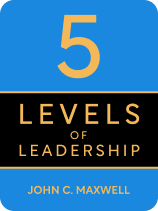

This article is an excerpt from the Shortform book guide to "The 5 Levels of Leadership" by John C. Maxwell. Shortform has the world's best summaries and analyses of books you should be reading.
Like this article? Sign up for a free trial here .
Is The 5 Levels of Leadership worth reading? What are the five stages/levels of leadership, according to its author John C. Maxwell?
In The 5 Levels of Leadership, author John C. Maxwell gives a shape and form to something seemingly indefinable. He culls his knowledge and experience to come up with the Five Levels of Leadership, a roadmap to help you reach your full leadership potential: 1) positional leadership, 2) permissional leadership, 3) production leadership, 4) empowerement-based leadership, and 5) pinnacle leadership.
This The 5 Levels of Leadership review takes a look at the book’s context, background, and discusses its key strengths and weaknesses.
About the Author
Maxwell is an author, leadership expert, speaker, and pastor. He is the founder of EQUIP, a development organization that helps leaders around the world, as well as of INJOY, Maximum Impact Mentoring, and The John Maxwell Team. He regularly speaks to Fortune 500 companies, international government leaders, and diverse organizations. He has published numerous books, 12 of which have made it onto the New York Times Best Seller list. His most popular books are The 21 Irrefutable Laws of Leadership, Developing the Leader Within You, and The 21 Indispensable Qualities of a Leader. His other books explore topics like relationships, attitude, and self-improvement.
Maxwell was one of the authors included in Amazon.com’s 10th Anniversary Hall of Fame. He was also ranked No. 1 on Inc. magazine’s list of leadership and management experts. In 2019, he received the Horatio Alger Award, which is given to Americans who exemplify perseverance, leadership, and commitment to excellence.
Connect with John C. Maxwell:
Book’s Publication
The 5 Levels of Leadership: Proven Steps to Maximize Your Potential was published in 2011 by Center Street. The book references principles from The 21 Irrefutable Laws of Leadership, one of Maxwell’s most popular books.
Historical Context
In the first chapter, Maxwell writes that he started thinking about the importance of leadership in 1976. It took him five years to come up with the framework for the Five Levels of Leadership, and it became the most sought-after topic for his lectures. He states that he has taught the concept to all types of organizations in over 120 countries. In response to the interest from lecture attendees, Maxwell gathered the principles into a book.
Intellectual Context
Maxwell isn’t the only author to write about “Level 5 leadership,” the highest form of leadership in his system. Jim Collins devotes a chapter to the topic in his book Good to Great. While Maxwell references Collins’s work in The 5 Levels of Leadership, it’s unclear whether one inspired the other. Good to Great was published in 2001, 10 years ahead of The 5 Levels of Leadership, but Maxwell states that he began developing his concepts in 1976. There is no mention of Maxwell in Collins’s book.
Both authors state that Level 5 leadership is about leaving behind a legacy, but their hierarchies differ. Maxwell applies his five levels only to management and doesn’t take individual contributors (non-manager employees) into account, while Collins starts with individual contributors, works his way up to management in Level 3, and discusses leaders in Levels 4 and 5. Maxwell also believes that you build on preceding levels, so it’s not possible to go from Level 1 to Level 4 without mastering Levels 2 and 3. In contrast, Collins writes that it isn’t necessary to move in sequence, but he does believe that you need to embody all levels to be considered a Level 5 leader.
Below is a comparison of the two authors’ concepts:
| Maxwell | Collins | |
| Level 5 | Legacy-based leadership:Has a reputation for developing strong leaders and organizations | Executive:Funnels personal ambition into company success |
| Level 4 | Empowerment-based leadership:Develops other people | Inspiring leader:Motivates subordinates to perform better in pursuit of a vision |
| Level 3 | Results-based leadership:Gets things done | Effective manager:Organizes people to achieve objectives |
| Level 2 | Relationship-based leadership:Has earned people’s trust | Productive team member:A team player who uses individual skills to achieve team objectives |
| Level 1 | Title-based leadership:Has been given a role | A capable individual contributor:Contributes through knowledge and skills |
The Book’s Strengths and Weaknesses
Reviewers who appreciate the book say that it’s a quick and easy read, and that it clearly breaks down the different levels, offering tips that you can immediately apply.
Reviewers who are critical of the book argue that it doesn’t present anything new and that it can be repetitive. Some take issue with how the book tells readers what to do without going into detail about how to do it. (For example, Maxwell tells readers to channel personal productivity into leading a productive team without giving concrete ways to help team members become more productive themselves.) Others point out the lack of scientific basis, as the principles are based largely on anecdotal evidence and on Maxwell’s own experience, which some see as limited to his career as a pastor.
Maxwell’s definition of leadership has also received some criticism. Maxwell believes that leadership is influence—the more influence you have, the more effective you are as a leader and the higher up the leadership ladder you can go. He doesn’t delve deeply into the topic of influence in this book, perhaps because he’d already covered it in an earlier book, The 21 Irrefutable Laws of Leadership. Here, he writes that you can only be a leader if you have followers, and you can only have followers if you have influence. While he discusses the factors that make up influence (character, knowledge, intuition, experience, past success, and ability), he never defines what it is. A Harvard Business Review article offers a definition that seems in line with Maxwell’s idea of influence: using a strong emotional connection to affect the character, development, or behavior of others.
Even though Maxwell devotes a chapter to discussing influence and leadership in The 21 Irrefutable Laws of Leadership, it’s his snappy one-word definition that has become mainstream. However, some experts take issue with this oft-quoted definition, saying it’s an oversimplification. For example, coach, speaker, and professor David Burkus argues that it’s too broad, using a salesperson—someone who can influence others to make a purchase—as an example of a non-leader. Similarly, bestselling author Kevin Kruse points out that a mugger with a gun also has influence over his victim. In both instances, the kind of influence that people wield isn’t the kind associated with leadership.
Burkus goes further, saying that Maxwell’s definition doesn’t differentiate between good leaders and bad leaders. If leadership is merely influence, he says, then there are no bad leaders, and there’s no difference between Martin Luther King Jr. and Adolf Hitler.
Both critics thus expand Maxwell’s definition to include the pursuit of a goal. For Burkus, leadership is “the process of influencing others to work toward a mutually desired vision,” which eliminates non-leader influencers like salespeople, and weeds out bad leaders whose followers are just reluctantly going along. Meanwhile, Kruse narrows down the type of influence to social influence, adding that it should be used to maximize the efforts of others to accomplish a goal.
Perhaps Maxwell recognized that his original definition was lacking and sought to expand it as well. In a blog post, The John Maxwell Team acknowledges that influence can work either positively or negatively and writes that being a great leader “is all about having a genuine willingness and a true commitment to lead others to achieve a common vision and goals through positive influence.”
Commentary on the Book’s Approach
The 5 Levels of Leadership starts with Level 1, positional leadership, which is the type of leadership that comes with a job title. This assumes that readers have already worked their way up to a title. While some tips are general enough to be applied by anyone at any level, Maxwell doesn’t have any advice for those who wish to gain a foothold in the first rung of leadership.
As is typical of books in the leadership genre, The 5 Levels of Leadership cites ideas and anecdotes from other books to support its concepts. The book’s strength lies in its ability to give a clear picture of the leadership hierarchy and what it requires. It also breaks down some leadership concepts like building self-awareness, nurturing relationships, and communicating effectively into more concrete, actionable tips.
Commentary on the Book’s Organization
Maxwell writes that you first have to master one level before moving on to the next, saying that you build upon the previous level. The book thus follows this logical flow, moving from the foundational principles of Level 1 leadership to Level 5 leadership, which encompasses all the leadership behaviors and qualities of the previous four levels. Each chapter covers one leadership level and discusses:
- Upsides—the positive aspects of each level
- Downsides—the negative aspects of each level; the higher you go, the fewer downsides there are
- Best behaviors—how to make the most of each level
- Laws of leadership—the related principles from The 21 Irrefutable Laws of Leadership
- Beliefs to help a leader move to the next level—ideas that you must embrace to be able to progress
- Guide to growing through the level—actionables to help you get to the next level
The final chapter of the book is a portrait of a Level 5 leader, Coach John Wooden, a basketball Hall of Famer who led the UCLA Bruins to 10 NCAA titles in his last 12 seasons as a coach.

———End of Preview———
Like what you just read? Read the rest of the world's best book summary and analysis of John C. Maxwell's "The 5 Levels of Leadership" at Shortform .
Here's what you'll find in our full The 5 Levels of Leadership summary :
- How to go from being a leader in title only to a true leader
- How to create a legacy as a leader
- Why you have to help others move up after you've evolved as a leader






